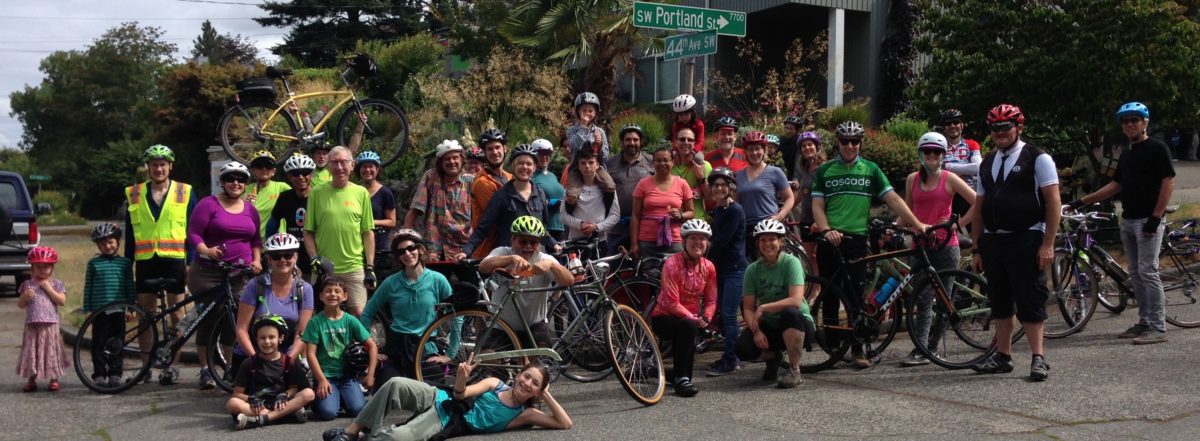Notes from May 17 meeting at Seattle Department of Transportation
Attending from SDOT:
Dongho Chang, City Traffic Engineer
Monica DeWald, Traffic Management Division, Pedestrian & Bicycle Program
Christopher Eaves, Traffic Management Division, Port and Freight
Attending from West Seattle Bike Connections:
Sakaru Tsuchiya, civil engineer specialist in pedestrian and bike facilities
Bob Anderton, attorney at Washington Bike Law
Jeff Hallman, VP of West Seattle Bike Connections, industrial design engineer
Don Brubeck, President of West Seattle Bike Connections, architect
Dongho Chang led the meeting, inviting our input. He noted that SDOT’s concern is to improve safety and legibility of the bike route for the benefit of bike riders and car and truck drivers. SDOT has been out observing conditions, doing traffic counts and talking to other stakeholders over the past two weeks since Lance David’s death in the crash at Hanford on May 1. We used a video from Monica’s bike commute from West Seattle to look at specific conditions.
Mayor McGinn has proposed allocating $700,000 in saving from the Spokane Street Viaduct project to immediate short-term improvements to East Marginal Way and WS Bridge Trail bike facilities, and $200,000 to design for ultimate long-term improvements. The engineering design would be enough to have a project ready to be eligible and competitive for construction funding grants.
This funding requires City Council approval.
We need to let City Council members know that we want this to happen!
Our requests for short-term improvements:
- Patch the pavement in bike lanes and at crossings.
- Sweep the streets on a frequent basis, due to deteriorated pavement.
- Build a safe crossing at Horton or Hanford, efficient for bikes, predictable for drivers.
- Fill the large puddles and provide drainage.
- Improve the sidewalk on west side to make it a safe, usable pedestrian/bike path. Move fire hydrants, trees between Spokane and Horton, utility poles and signs out of the sidewalk on the west side.
- At S Atlantic St/Alaskan Way transition to Portside Trail at Terminal 46:
- adjust the aiming of the traffic light video sensor to better detect northbound bikes in bike lane;
- add signage or pavement graphic to show northbound bikes where to stop;
- change southbound signal to be normally green instead of normally red for southbound ped/bike traffic, with vehicle sensors to change it to red southbound and green east-west or northbound left when needed.
- Request Port of Seattle to improve sightlines at terminal entries and exits by making fencing transparent or revising it for better sight triangles at curb cuts.
- Promote the improved multi-use path on Spokane St east of East Marginal Way to 6th Ave as option to get into SODO or other destinations to NE.
This funding requires City Council approval.
We need to let City Council members know that we want this to happen!
Long-term:
- Physical barrier separating bike from vehicle lanes on East Marginal Way from Spokane to Atlantic, connecting WS Bridge Trail to Portside Trail to Central Waterfront.
- Safe crossing at Horton or Hanford for bike traffic to SODO. Bike detectors, flashing beacons and right-on-red restriction if crossing is on north side of intersection.
We discussed pros and cons of location of separated cycle-track or multi-use path.
- One-way cycle tracks each side are good for fast riding without bike/pedestrian conflicts, but probably take too much right-of-way width and have challenges with intersections at Hinds, Horton and Hanford. Deletion of center turn lane is probably not an option due to queuing needs for trucks at terminal entries.
- A wider two-way multi-use path on the west side from Spokane to Hanford, crossing over to a two-way cycle track on the east side from Hanford to Atlantic would avoid conflict with Port terminal entries. However, it still requires a lane crossover in heavy traffic at Atlantic to get back to Portside trail on the west, so that would still be discouraging for many potential users.
- A two-way cycle track or wide multi-use path on east would be more “legible” and direct, and avoid the need for crossing East Marginal and making one or two lane cross-overs when going northbound. However, this requires more driveways to cross and has pedestrian conflicts.
Dongho said that the majority opinion so far from various stakeholders is that a separated route all on the west side would be best. We noted that if that approach is taken, there will still be a need for a safe crossing into SODO and east to Fourth Ave S for some bike riders at Hanford or Horton, and safety on west side will require considerably more width, much better sightlines at terminal entries, and consideration of bike/pedestrian conflicts.
For short-term fixes, Monica noted that the poor soil and pavement conditions mean that any paving patching or overlays are almost immediately destroyed by truck traffic. The long-term plan is to completely repave this road as a heavy truck haul route with much more robust paving, In the meantime, patches and street sweeping can help some. Monica noted that filling for drainage fixes have not worked at the puddles. There is nowhere for the water to go. It just moves the puddles, then the patch deteriorates and it moves back.
Dongho said that they are now looking at a short term multi-use path on the east that would widen the sidewalk by taking planting area and bike lane area, raising it up with ashalt paving and a curb. This would provide the width needed for two-way bike and pedestrian traffic and get bikes up away from the puddles. This could be accomplished within the proposed funding and not require lengthy land negotiations with the Port or BNSF. This is not yet decided. SDOT is exploring options and inviting suggestions.
This funding requires City Council approval.
Please let City Council members know that you want this to happen!













